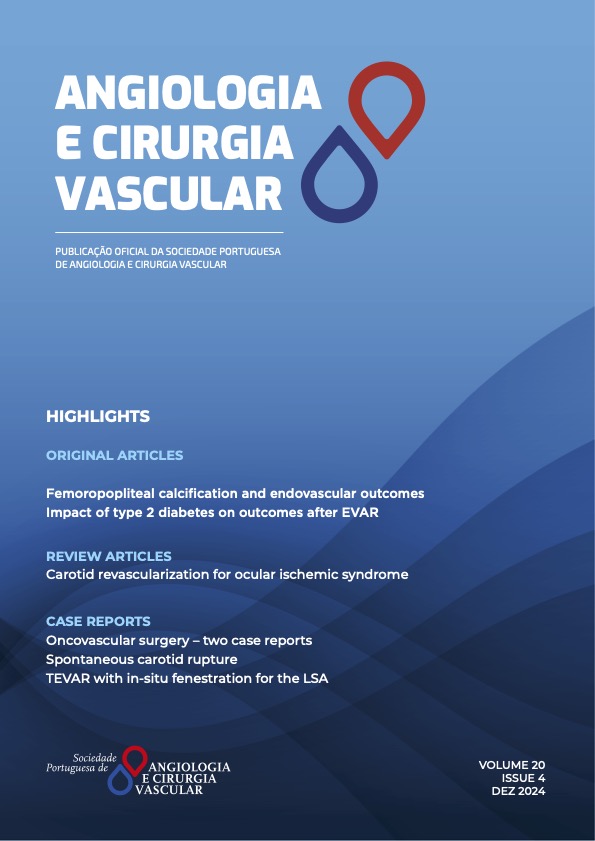Risk factors for type 2 endoleak following endovascular aneurysm repair of abdominal aortic aneurysms
DOI:
https://doi.org/10.48750/acv.608Keywords:
Abdominal aortic aneurysm, endovascular repair, type 2 endoleak, embolizationAbstract
INTRODUCTION: Type 2 endoleaks (T2EL) are common complications following endovascular aneurysm repair (EVAR), potentially leading to adverse outcomes such as aneurysm sac growth and reintervention. Although current guidelines recommend surveillance and conservative management for most T2EL cases, there's growing interest in prophylactic measures, including embolization of lumbar (LA) and inferior mesenteric arteries (IMA) during EVAR. This study aims to investigate the impact of LA and IMA on the development of T2EL after EVAR and to identify associated risk factors.METHODS: A retrospective analysis was conducted on patients who underwent elective EVAR for infrarenal aortic aneurysms at our institution between January 2020 and December 2022, without embolization of LA or IMA. All patients had preoperative and one-month post-operative computed tomography angiography (CTA). Patient demographics, aneurysm characteristics, LA and IMA patency and diameter were registered. Evidence of T2EL was assessed at one and 12 months after surgery, in addition to sac growth.
RESULTS: Fifty-eight patients were included, with a median age of 75 and mean aneurysm size of 64mm at the time of treatment. Most patients were male (n=56). Eighteen patients (31%) exhibited a T2EL on follow-up. Aneurysm shape was associated with T2EL, with 62% of saccular aneurysms developing T2EL, whilst only 26% in fusiform aneurysms (p=0.039). Patients with T2EL had a higher number of covered LA than patients without (5.33 and 5 vs 4.6 and 3.45, respectively), yet only patent covered LA achieved statistical significance for T2EL (p=0.195 and p=0.025, respectively). Additionally, T2EL showed significant association with covering > three patent LA (78%, p=0.020); similarly, IMA patency was associated with T2EL (100% vs 65% without T2EL, p=0.003). Presence of lumbar and inferior mesenteric arteries with ≥ 3 mm, mean LA and IMA diameter, as well as sum of combined diameters did not reach significance, despite being slightly higher in the T2EL group. Among the 18 patients with T2EL, three (17%) had sac growth and two (11%) sac shrinkage (defined as variation ≥ 5mm) at 12 months, none of which required reintervention. One patient had concomitant type 3 endoleak, and underwent endograft relining.
CONCLUSION: This study reveals a substantial incidence of T2EL following elective EVAR, emphasizing the importance of further understanding associated risk factors. Saccular aneurysm morphology, more than three patent covered LA, and patent IMA were identified as significant predictors of T2EL, whilst collateral vessel diameter did not achieve significance. While prophylactic embolization of LA and IMA may benefit certain patients, the lack of association between vessel diameter and T2EL warrants additional investigation to refine embolization strategies.
Downloads
References
Wanhainen A, Van Herzeele I, Bastos Gonçalves F, Bellmunt Montoya S, Berard X, Boyle J, et al. Editor's Choice -- European Society for Vascular Surgery (ESVS) 2024 Clinical Practice Guidelines on the Management of Abdominal Aorto-Iliac Artery Aneurysms. Eur J Vasc Endovasc Surg. 2024;67:192-331.
Chen JX, Stavropoulos SW. Type 2 Endoleak Management. Semin Intervent Radiol. 2020;37:365-70.
Varino J, Vale Pereira R, Mendes C, Marinho A, Rodrigues R, Gonçalves A, et al. Impact of Type-II Endoleak on Aneurysm Sac in a Single Center. Angiol Cir Vasc. 2017;13:26-34.
Ultee KHJ, Büttner S, Huurman R, Bastos Gonçalves F, Hoeks S, Bramer W, et al. Editor's Choice - Systematic Review and Meta-Analysis of the Outcome of Treatment for Type II Endoleak Following Endovascular Aneurysm Repair. Eur J Vasc Endovasc Surg. 2018;56:794-807.
Kuijpers M, Holewijn S, Blankensteijn JD, Reijnen MMPJ. Prevalence of type II endoleak after elective endovascular aneurysm repair with polytetrafluoroethylene- or polyester-based endografts. J Vasc Surg. 2024;79:24-33.
Chaikof EL, Dalman RL, Eskandari MK, Jackson BM, Lee WA, Mansour MA, et al. The Society for Vascular Surgery practice guidelines on the care of patients with an abdominal aortic aneurysm. J Vasc Surg. 2018;67:2-77.e2.
Seike Y, Matsuda H, Shimizu H, Ishimaru S, Hoshina K, Michihata N, et al. Nationwide Analysis of Persistent Type II Endoleak and Late Outcomes of Endovascular Abdominal Aortic Aneurysm Repair in Japan: A Propensity-Matched Analysis. Circulation. 2022;145:1056-66.
Lo RC, Buck DB, Herrmann J, Hamdan AD, Wyers M, Patel VI, et al. Risk factors and consequences of persistent type II endoleaks. J Vasc Surg. 2016;63:895-901.
Otsu M, Ishizaka T, Watanabe M, Hori T, Kohno H, Ishida K, et al. Analysis of anatomical risk factors for persistent type II endoleaks following endovascular abdominal aortic aneurysm repair using CT angiography. Surg Today. 2016;46:48-55.









